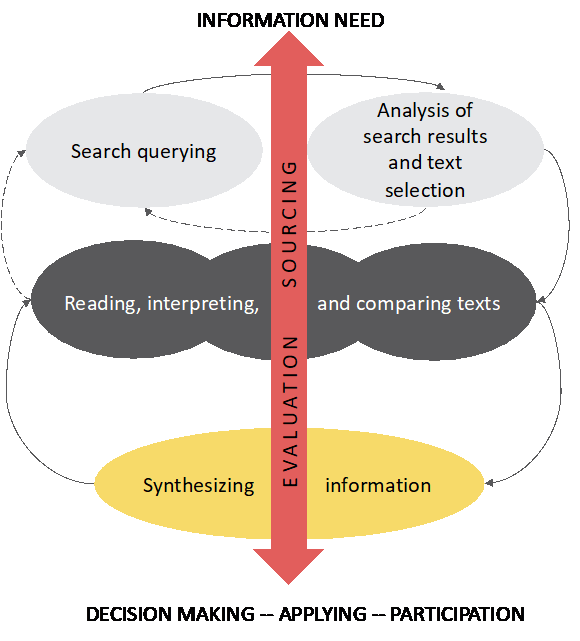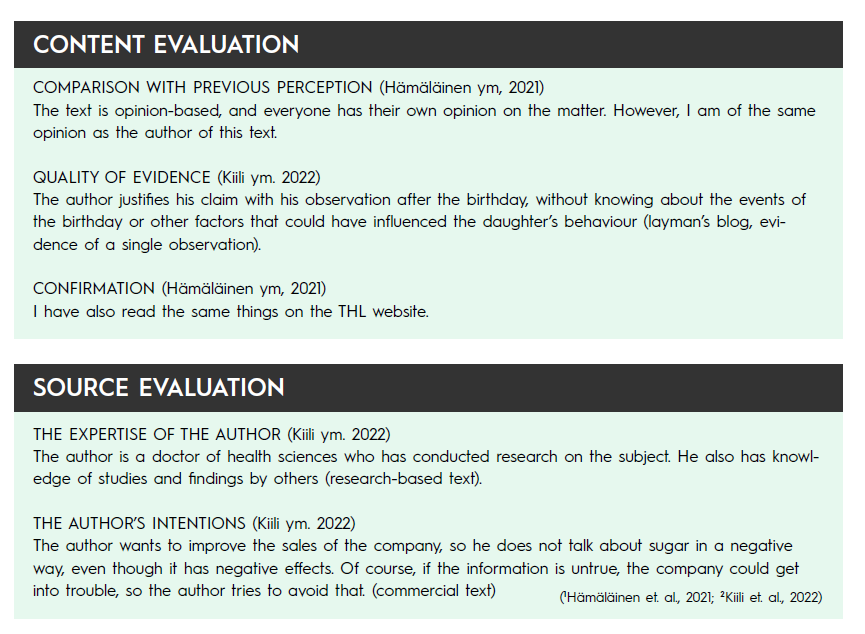The internet is seen as an up-to-date repository of information, where the information one needs is just a Google search away. The internet is an essential resource for formal and informal learning. It is also used to search for information to support decision-making in various settings, whether it is about buying a new phone or making a health-related decision. When the readers’ goal is to understand a complex phenomenon, examine a controversial issue from different perspectives, or make an important decision, the information is no longer a Google search away. Achieving a deep understanding of the issue under examination requires complex processing, as well as the monitoring and regulation of these processes (Kiili et al., 2009).
Online inquiry is a cyclical process
The complex and cyclic process of online inquiry is illustrated in Figure below (cf. Leu et al., 2019; see also Kiili et al., 2021). Notably, the depicted process is ideal and does not necessarily apply to all situations and for all readers. Online inquiry begins with specifying the information needed: the kind of information a reader needs to solve a problem or reach a deep understanding of the phenomenon at hand. In specifying the information needs, readers can also consider sources that would provide credible information. Specifying the information needs is crucial, as it guides online reading processes and the monitoring and regulation of these processes. It is worth mentioning that although specifying the information need initiates online inquiry, it can also become more specific or even change during the inquiry.
Once the information need has been specified, readers can search for information using search engines. To formulate effective search queries, readers consider core concepts and limiting concepts that can relate to content or sources (e.g., organization, profession). Readers analyze search results by using a title, a website address, or an example text. Which search results could meet the information need and lead to credible information? If the search results do not seem promising, readers are required to revise their search queries. Skillful readers can modify their searches by considering alternative expressions, concepts, and sources.
After locating relevant online texts, readers can evaluate them more carefully. If the texts seem credible, readers move on to interpreting single texts and comparing multiple texts. If the information need is not met (texts are not relevant or credible, or some important point of view is missing), the reader returns to the information search phase.
A synthesis—an integrated mental model of online texts (cf. Rouet, 2006)—is gradually constructed during the iterative process of inquiry. In school assignments, students are often asked to produce a written or multimodal product based on multiple online texts that reflect the synthesis. In the synthesis, readers integrate ideas from multiple texts into a coherent whole. The synthesis also includes information about the sources, such as, Who said what? How do different sources support or contradict each other? Readers can use the synthesis, for example, in decision-making or participation in a societal discussion.

Figure: The iterative processes of online inquiry where information evaluation and sourcing are cross-cutting processes
Online inquiry requires criticality
Online inquiry requires critical reading skills. Critical reading refers to an individual’s ability to analyze, evaluate, and interpret information of varying quality and recognize how different texts can be used to persuade or mislead (see Critical, 2021). Credibility evaluation and sourcing are cross-cutting processes in critical online reading (Figure), which I will next explore in more detail.
Credibility evaluation during online inquiry
Credibility evaluation can occur while searching for information, reading online texts, and synthesizing them. In the search phase, credibility evaluation is predictive, as the search results provide only a limited amount of information to support evaluation. Predictive evaluation becomes more precise when readers can examine online texts in more detail and compare the content of multiple online texts. According to Barzilai et al. (2020), credibility evaluation is a bi-directional process in which readers evaluate the content’s validity and the source’s trustworthiness (e.g., author, publisher). Readers’ judgments about content validity are reflected in the evaluation of the source’s trustworthiness, and judgments about the source’s trustworthiness are reflected in the content validation.
Credibility evaluation aims to determine whether the text content is accurate. Readers can evaluate the content by a) comparing the content with their prior knowledge and beliefs about the topic, b) examining the quality of argumentation, and c) validating the accuracy of the content against the other texts (Barzilai et al., 2020). However, if readers do not have much prior knowledge or if their prior beliefs are incorrect, validating content against prior knowledge and beliefs can be difficult or even harmful. Namely, the stronger readers’ misconceptions about the text topic are, the more inclined they are to judge the text that supports their misconceptions as credible (Kiili et al., under review; van Strien et al., 2016).
Readers can also evaluate the author’s argumentation from different perspectives: What kinds of rhetorical means does the author use? Is argumentation logical? What does the author argue, and how does he or she support the argument? For example, readers can consider the credibility of the provided evidence. Is the author relying only on personal experiences, or does the author present research evidence to support the claims? Our research shows that students need support to understand what kind of evidence can be regarded as credible when determining cause–effect relationships. For example, only about a quarter of the sixth graders (N = 265) perceived that personal experience could not prove a cause–effect relationship (Kiili et al., 2022b). Many upper secondary school students also struggled to justify why one should be cautious when personal experience is presented as evidence of a causal claim (Kiili et al., 2022a).
Content validity can also be examined by comparing the content of several texts, a strategy called corroboration. Ideally, readers will use several texts to determine the prevailing scientific understanding of the explored issue (Osborne et al., 2022). When we studied credibility evaluation of online texts among more than three hundred upper secondary students, corroboration was the least used evaluation strategy (Hämäläinen et al., 2021). In their evaluations, students paid the most attention to the publication venue. While 89% of students considered the publication venue at least once when evaluating three online texts, the corresponding proportion was 14% for corroboration.
Evaluation of the source (e.g., author, publication venue) is particularly important when readers have little or no prior knowledge of the topic under examination (Bråten et al., 2018a). When evaluating a source, readers can consider several source features, such as the author’s expertise, benevolence, and integrity (Hendriks et al., 2015). Readers can draw conclusions about the author’s expertise by paying attention to the author’s education, profession, position, or affiliation. Notably, it is not sufficient to quickly check credentials. Readers should consider whether the author has expertise, particularly in the topic of the text (Osborne et al., 2022). This should be discussed in classrooms because, in social media, for example, experts from different fields present statements on topics that are not at the core of their expertise. In our study, where we examined pre-service teachers’ (N = 169) credibility evaluation skills, we found that only 8–20% (depending on the text) of them considered the relationship between the author’s expertise and the topic of the text (Kulju et al., in preparation).
In addition to the author’s expertise, readers may also consider the author’s or publisher’s intentions and integrity. For example, readers can consider whether the author has commercial or political intentions. For younger readers, identifying commercial intentions is not self-evident, even if they are obvious (e.g., company websites). When 63% of the sixth graders identified commercial intentions in a multiple-choice task (Kiili et al., 2022b), only 19% of them questioned the credibility of a commercial web page when they were required to justify their credibility evaluation in an open-ended task (Kiili et al., 2018).
In Table below, I have compiled examples of content- and source-based justifications that upper secondary school students gave for their credibility evaluations. Notably, justifications can include both content- and source-related considerations. For instance, in the last example, a student identifies commercial intentions (source) and considers how these intentions are reflected in the author’s argumentation (content). In addition, the student seems to be aware of the legislation that protects consumers, stating that marketing must also be in accordance with good practice.

Table: Examples of upper secondary school students’ justifications for their credibility evaluations when reading health-related texts.
Sourcing during online inquiry
The evaluation of the trustworthiness of sources is an integral part of sourcing. However, sourcing is a broader construct than source evaluation and is defined as paying attention to, evaluating, presenting, and using sources of information (Bråten et al., 2018b). Importantly, sourcing can occur throughout online inquiry, and it is an essential part of critical online reading (Kiili et al., 2021). When specifying their information needs, readers can consider which sources could provide credible information on the topic under examination. Readers can then use these considerations to formulate their search queries by including trustworthy persons, organizations, or professions in their search queries. For example, if readers want to know what monkeypox is and how it spreads, they can limit their search to the CDC website (Centers for Disease Control and Prevention) by typing in Google “monkeypox site: cdc.gov”. If readers do not know any specific publication venue, they can also limit their search by profession, such as “professor,” to increase the probability of finding research-based information about monkeypox.
Sourcing is also an essential part of interpreting, comparing, and synthesizing multiple online texts. Sourcing plays a pivotal role, particularly when readers explore controversial issues (Rouet, 2006). Namely, skillful readers pay attention to who says what, which is forming source–content links. When readers consider how the views of different sources support or oppose each other, they form source–source links. When readers compose a source-based essay, sourcing is not just a matter of compiling a list of sources. At its best, a written product provides information on the views of different sources and their relationships.
Our study showed that upper secondary school students engaged in sourcing throughout the online inquiry (Kiili et al., 2021). However, sourcing was relatively scarce in search querying. Interestingly, sourcing in the earlier phases of inquiry contributed to sourcing in the later phases of inquiry. The more frequently upper secondary students (N = 167) engaged in sourcing when specifying their information needs or formulating their search queries, the more frequently they also engaged in sourcing in their credibility judgments. Further, the more frequently students engaged in sourcing in their credibility judgments, the more frequently they used sources in their writing. These findings suggest that instruction should emphasize sourcing as a continuous process that begins early on.
The CRITICAL project aims to support children’s and adolescents’ critical reading
In this article, I have described how criticality may ideally appear during online inquiry. However, our research among adolescents in Finland shows considerable inter-individual differences in adolescents’ online inquiry skills and criticality. While some students need support with basic skills, others need more challenges to further develop as critical online readers. In the CRITICAL project, funded by the Strategic Research Council, we investigate children’s and adolescents’ critical reading skills, including supporting and hindering factors for development. In addition, we develop research-based methods and materials to support critical reading in classrooms (see educritical.fi/en).
References:
Barzilai, S., Thomm, E., & Shlomi-Elooz, T. (2020). Dealing with disagreement: The roles of topic familiarity and disagreement explanation in evaluation of conflicting expert claims and sources. Learning and Instruction, 69, Article 101367. https://doi.org/10.1016/j.learninstruc.2020.101367
Bråten, I., Stadtler, M., & Salmerón, L. (2018). The role of sourcing in discourse comprehension. In M. F. Schober, D. N. Rapp, & M. A. Britt (Eds.), Routledge handbooks in linguistics. The Routledge handbook of discourse processes (p. 141–166). Routledge/Taylor & Francis.
Critical. (2021). Teknologisia ja sosiaalisia innovaatioita kriittisen lukemisen tukemiseen internetin aikakaudella (CRITICAL): Tilannekuvaraportti 2021. https://www.aka.fi/globalassets/3-stn/1-strateginen-tutkimus/strateginen-tutkimus-pahkinankuoressa/tilannekuvaraportit/stn2020-hankkeet/tilannekuvaraportti-critical.pdf
Hendriks, F., Kienhues, D., & Bromme, R. (2015). Measuring laypeople’s trust in experts in a digital age: The Muenster Epistemic Trustworthiness Inventory (METI). PLoS ONE, 10(10), e0139309. https://doi.org/10.1371/journal.pone.0139309
Hämäläinen, E., Kiili, C., Räikkönen, E., & Marttunen, M. (2021). Students’ abilities to evaluate the credibility of online texts: The role of Internet-specific epistemic justifications. Journal of Computer Assisted Learning, 37(5) 1409–1422. https://doi.org/10.1111/jcal.12580
Kiili, C., Bråten, I., Strømsø, H., Hagerman, M.S. Räikkönen, E. & Jyrkiäinen, A. (2022a). Adolescents’ credibility justifications when evaluating online texts. Education and Information Technologies. https://doi.org/10.1007/s10639-022-10907-x
Kiili, C., Bråten, I., Strømsø, H., & Räikkönen, E. (2022b). Why trust or mistrust? Sixth graders’ ability to justify the credibility of online texts. Hyväksytty esitelmä EARLI SIG2, 29.8-31.8.2022, Kiel, Saksa
Kiili, C., Forzani, E., Brante, E. W., Räikkönen, E., & Marttunen, M. (2021). Sourcing on the Internet: Examining the relations among different phases of online inquiry. Computers and Education Open, 2. Article 100037. https://doi.org/10.1016/j.caeo.2021.100037
Kiili, C., Leu, D. J., Marttunen, M., Hautala, J., & Leppänen, P. H. T. (2018). Exploring early adolescents’ evaluation of academic and commercial online resources related to health. Reading and Writing, 31, 533–557. https://doi.org/10.1007/s11145-017-9797-2
Kiili, C., & Laurinen, L. (2018). Monilukutaidon mestariksi: Opettaja nettilukemisen ohjaajana. Jyväskylä: Niilo Mäki Instituutti.
Kiili, C., Räikkönen, E., Bråten, I., Strømsø, H. I. & Hagerman, M. S. (arvioitavana). Adolescent readers’ online evaluation skills are made of abilities to confirm the credibility and question the credibility.
Kulju,P., Hämäläinen, E., Mäkinen, M., Räikkönen,E., & Kiili, C. (valmisteilla). Pre-service teachers evaluating online texts about learning styles: There is room for improvement in justifying credibility.
Leu, D. J., Kinzer, C. K., Coiro, J., Castek, J., & Henry, L. A. (2019). New literacies: A dual level theory of the changing nature of literacy, instruction, and assessment. In D. E. Alvermann, N. J. Unrau, M. Sailors, & R. B. Ruddell (Eds.), Theoretical models and processes of literacy ( 7th ed., pp. 319– 346). Taylor & Francis.
Osborne, J., Pimentel, D., Alberts, B., Allchin, D., Barzilai, S., Bergstrom, C., Coffey, J., Donovan,B., Kivinen, K., Kozyreva. A., & Wineburg, S. (2022). Science education in an age of misinformation. Stanford University, Stanford, CA
van Strien, J. L. H., Kammerer, Y., Brand-Gruwel, S., & Boshuizen, H. P. A. (2016). How attitude strength biases information processing and evaluation on the web. Computers in Human Behavior, 60, 245–252. https://doi.org/10.1016/j.chb.2016.02.057
Carita Kiili is an Academy Research Fellow at the Faculty of Education and Culture, Tampere University where she leads the Educating for future literacies research group. She holds a title of docent in digital literacies at the University of Lapland. Kiili’s research focuses on developing and testing methods to assess and support students’ critical online reading skills.
Artwork: Lumi Pönkä
Download the Digital Information Literacy Guide (PDF).

